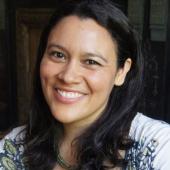Meet First Nations Theater
Twin Cities, meet First Nations Theater. First Nations Theater, meet the Twin Cities. I think the two of you have a lot in common, and I’m actually quite surprised you haven’t met before. What’s that, First Nations Theater? You say you knew about the Twin Cities, but never really got introduced properly? Well then, I’m glad I could help the two of you get to know each other a little bit better.
The Twin Cities are home to one of the largest urban Native American populations in the country, and one of the largest theater communities in the U.S. with the number of companies here hovering around 100 – a figure that also includes culturally diverse performing arts. Yet the major missing piece of this puzzle is theater that speaks to the Native American experience. Why haven’t these two met?
The argument I’ve heard over and over again justifying the absence of Native American stories on stage has been that there aren’t any Native American plays and playwrights out there to produce.
But the reality is Native American playwrights and plays do exist. Native American plays and playwrights have been flirting with theater that combines their own cultural expressions and Western traditions since European writing systems were introduced to the Western Hemisphere. There are 300-year-old plays written in Spanish by Mayan playwrights, and Native American theater writers have been around at least as far back as the Chautauqua Circuit.
The Canadian equivalent of “Native American” is “First Nations.” It is a name that reflects the idea of self-determination, and it encompasses the ability to maintain and perpetuate a national identity. It also connotes the fact that they were there first. This is a notable difference of control in the way their identity is named in contrast to “Native American,” a label that connotes a certain amount of concession of autonomy because its based on the identity of another country. Perhaps this gives some clue or insight as to why First Nations theater is so vibrant.
In Canada, there is an enormous canon of “First Nations” plays. Like the mounties and hockey players, it sometimes seems like you can’t walk two blocks without running into a First Nations playwright! Ok, maybe that’s not exactly true, but to this “Native American” playwright, the streets of Canada seem to be paved with the golden pages of plays written by indigenous people.
Canada’s media is also quite tuned in to the First Nations experience. There have been numerous television shows with all aboriginal casts, and there’s even a cable channel called Aboriginal People’s Television Network with children’s shows in English, French, Cree, Inuit, and Ojibwe to name a few. There’s also music programming, and national evening news, cooking shows, and sitcoms. Though First Nations, like Native Americans, are still cultures at risk as they deal with the history of out right genocide, current institutionalized genocide in the form of blood quantum requirements and vast inequalities in the justice system, and internalized oppression, their concerns are at least being heard by mainstream Canada.
Birth of a Renaissance
This First Nations artistic and media renaissance began in October of 1986 when a Cree playwright named Tomson Highway produced a play called Rez Sisters at Toronto’s Native Earth Performing Arts. When the play first opened, Tomson and the producers were literally out on the street, giving away tickets to try to find an audience. By the end of their run, the play sold out every night, and the line for tickets flowed down the street.
Mainstream Canadian theater artists and audiences were amazed at the new story they were hearing and the uniquely Native way that the story was written. Defying Aristotelian single protagonist structure, the play focused on the journey of seven women on a reserve (reservation) trying to get to the world’s largest Bingo while Nanabush, the Ojibwe trickster, watched and slipped in and out of their lives. Demonstrating indigenous values, it is the story of the community rather than the individual. The play went on to win the Canadian version of a Tony, the Dora Mavor Moore Award, for Best New Play that year.
Quickly following this tear in the mainstream Canadian theater fabric came other playwrights like Drew Hayden Taylor, Daniel David Moses, Maria Campbell, Marie Clements, Monique Mojica, Ian Ross, Yvette Nolan and others. They all opened historical wounds finally allowed to be acknowledged and created beautiful plays from years of painful forced silence and oppression.
Highway is often credited for saying, “Before the healing can take place, the poison must first be exposed.” And the first wave of plays did just that. Look at your colonial past, look at your genocide, they told Canada, look at your institutions that perpetuate the exploitation and silence of indigenous people. It’s not ok for aboriginal people to be invisible. It’s not ok for aboriginal people to suffer.
It was common to see the metaphor of rape show up over and over in plays. Highway’s next play was Dry Lips Oughta Move to Kapuskasing, a male version of Rez Sisters. Both have graphic rape scenes. But more than the horror of the act, Highway uses these images to transcend the brutality of cultural and physical rape and shows that through it all aboriginal people have survived – which is in itself the ultimate statement on a continent that was built on the disappearance of millions of indigenous lives.
With humor too
By the mid 1990s, First Nations plays began to talk about more than just tragedies – And the big secret about how Native communities survived years and years of oppression and racism came out: Humor. With his Blues Quartet, Drew Hayden Taylor set out to write comedies that celebrated the aboriginal funny bone: "The Baby Blues," "The Bootleggers Blues," "The Buz Gem Blues," (produced at Trinity Repertory in 2003) and "The Berlin Blues."
Many of these First Nations authors and their plays have won Canada’s top script honors, and mainstream Canadian theaters routinely produce First Nations work now. The closest Canadian regional theater to Minnesota, 600 miles due north, is Magnus Theater in Thunder Bay, Ontario. Two years ago, they noticed the common appearance of First Nations plays in their seasons and decided to mandate the inclusion of at least one aboriginal production per year. Thunder Bay’s ratio of First Nations population to non-Native is roughly the same as the Twin Cities.
So why not have it happen here? These are just three matches that could make a Twin Cities’ theater season happy.
1. In a World Created by a Drunken God by Drew Hayden Taylor, was nominated for a 2006 Governor General’s Award. It is the story of two brothers: one a white American, one First Nations. They don’t know of each other until the father of the white son needs a kidney transplant and sends him off to find his Ojibwe brother. The cast is very small —only the two actors. Taylor is best known for his comedy, and two of his short plays are included in the upcoming Mixed Blood spring production of Red Ink, a multi-playwright project featuring Native American and First Nations authors.
2. Sneaky by William S. Yellow Robe Jr. is not a Canadian play. However, like First Nations Theater, this Native American playwright’s work is virtually unknown to mainstream theaters—and in my opinion, not given enough credit for the colonial dirt his work digs up (even though he has been produced by The Ensemble Studio Theatre and Trinity Repertory). I directed this play in Albuquerque, New Mexico when I was a co-associate artistic director of Yellow Robe’s now defunct Native American theater ensemble, Wakiknabe, in 1999. It’s a cheeky play that jabs at the commoditization of death. Three brothers scheme to rescue their deceased mother from the morgue so that they can give her a traditional Assinaboine burial. And, again, a small cast of only three Native men and one non-Native man.
3. Tombs of the Vanishing Indian by Marie Clements, a Governor General-nominated author, is not even published yet. In February, it had a reading in Toronto at Native Earth Performing Art’s annual Weesageechak Festival of new First Nations plays. It is a multicultural cast of four native women and three white men. The play is set in Los Angeles and deals with the Nixon Family Planning Act that often secretly sterilized poor women of color, especially Indian women.
While you can pick up a copy of In a world. . . and Sneaky on the Internet or at Birchbark Books, you’ll have to contact Native Earth to read this play.
Additional Reading:
The Rez Sisters by Tomson Highway
Dry Lips Oghta Move to Kapuskasing by Tomson Highway
Burning Vision by Marie Clements
The Indian Medicine Show by Daniel David Moses
Princess Pocahontas and The Blue Spots by Monique Mojica
Toronto at Dreamer’s Rock by Drew Hayden Taylor
Jessica by Linda Griffiths and Maria Campbell
Only Drunks and Children Tell the Truth by Drew Hayden Taylor
Farewell by Ian Ross
The Red Road by Arrigon Starr
Song Catcher: Native perspective of the life of Frances Densmore by Marcie Rendon




